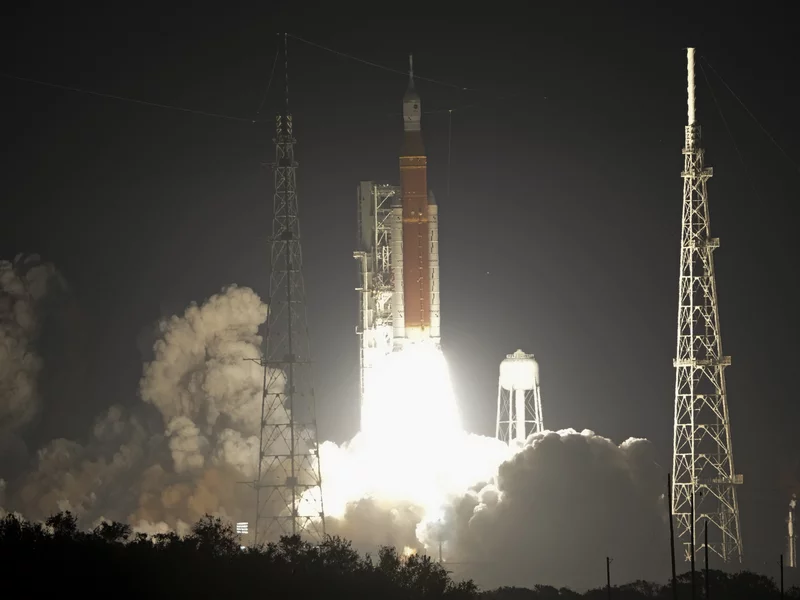CAPE CANAVERAL, FLORIDA- It's the rocket that skeptics despise, dismissing it as excessively costly, outmoded, and a vehicle more suited to create employment in critical district lines than exploring the universe.
Following the 50th anniversary of NASA's Apollo missions, NASA launched the very next Artemis mission to the moon, which blasted off last week with three test dummies onboard, putting the United States closer and closer to returning people to the lunar surface.
The predawn sky above Florida's space coast lighted up early on Wednesday as NASA's massive 322-foot-tall moon rocket rocketed off its launch pad. Orion, a white, bell-shaped capsule, has officially begun a 25-day test mission that will carry it around the moon and back. The 1.2-million-mile journey will put NASA another step closer to its aim of restoring mankind to the surface of the moon.
Delays Before the Successfully Flight
After years of delays and billions of dollars in cost overruns, the Space Launch System rocket thundered upward, soaring beyond Kennedy Space Center on 8.8 million pounds (4 million kilograms) of force and reaching 100 mph (160 kph) in seconds. Following The Washington Post's statement, the Orion spacecraft was situated on top not nearly two hours into the mission, preparing to launch from Orbit around the earth for the moon.
Then after almost three months of persistent fuel leaks that prompted the rockets to bounce in between the hangar and the pad, the moonshot finally occurred. Being pushed back in by Hurricane Ian at the beginning of September, the rockets stayed outside while Hurricane Nicole roared over this past week with gusts of further than 80 mph (130 kph). Even though the wind had dragged away a 10-foot (3-meter) piece of caulking high off the ground near the capsule, management gave it a go for the launch, as per NPR.
The Orion capsule shall orbit the moon, arriving within around 80 miles of its ground, and its greatest distance from Earth would be 268,553 miles, breaking the mark established during NASA's Apollo 13 expedition in 1970.
NASA estimated 15,000 people to crowd the launch facility, with thousands more surrounding the beaches and roads beyond the gates, to see NASA's long-awaited follow-up to Project Apollo, which witnessed twelve astronauts trek on the moon throughout 1969 and 1972. Crowds gathered outside NASA facilities in Houston & Huntsville, Alabama, to view the show on large screens.

NASA's new moon rocket lifts off from Launch Pad 39B at the Kennedy Space Center in Cape Canaveral, Fla., Wednesday, Nov. 16, 2022. This launch is the first flight test of the Artemis program.
ALSO READ: NASA's Artemis 1 Moon Rocket Lifespan Ticking as Boosters May Expire in December
Artemis II and Other Future Expeditions
As reported by the Economic Times, cheers greeted the launch as it rode a massive trail of flame toward space, with a half-moon blazing brightly and buildings trembling as if struck by a tremendous quake. This is for the Artemis generation, said launch director Charlie Blackwell-Thompson, referring to everyone born after Apollo.
If everything goes as planned, NASA intends another voyage, named Artemis II, with people to orbit the moon in 2024. A lunar mission is planned for 2025, although many believe it would be later. NASA plans to utilize a separate spaceship manufactured by Elon Musk's SpaceX to transport humans to the surface.
While the lunar landing is still decades away, the successful flight of Artemis I was a significant moment again for the space agency. NASA has not flown a person above low Earth orbit ever since the final Apollo mission in 1972, whereupon astronaut Eugene Cernan pledged "we shall return" in a brief statement before climbing back into the lunar module for such a trek back to Earth.
RELATED ARTICLE: NASA Says a Dangerous Fuel Leak Would Cause Artemis 1's SLS Spacecraft to Explode if Not Fixed
Check out more news and information on Space in Science Times.










!['Cosmic Glitch' in Einstein's Theory of General Relativity Could Be Explained in This New Scientific Tweak [Study]](https://1721181113.rsc.cdn77.org/data/thumbs/full/53435/258/146/50/40/cosmic-glitch-in-einsteins-theory-of-general-relativity-could-be-explained-in-this-new-scientific-tweak-study.jpeg)



